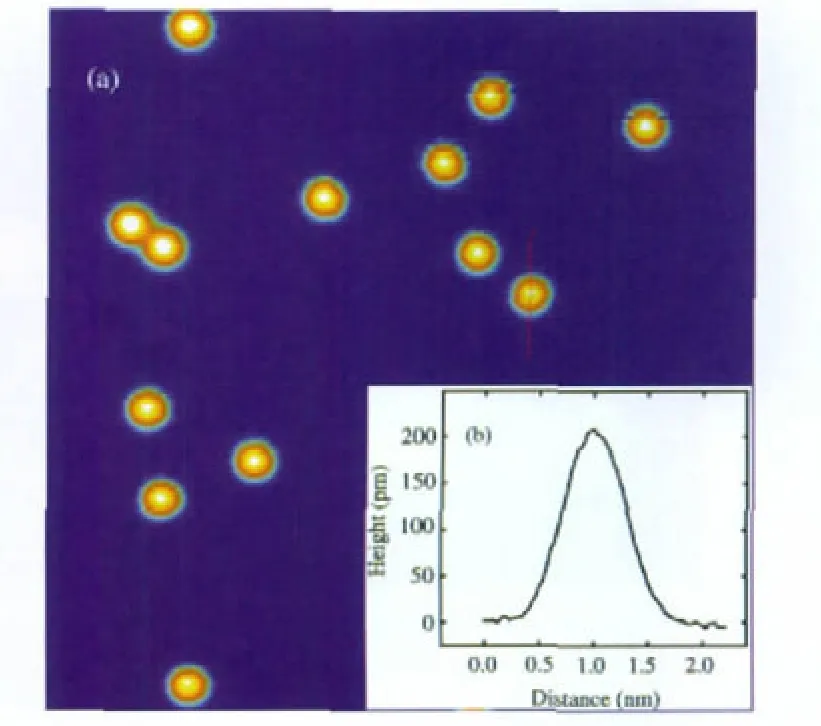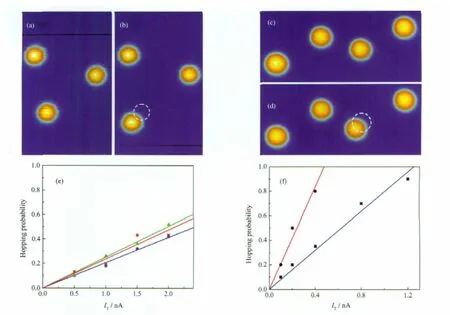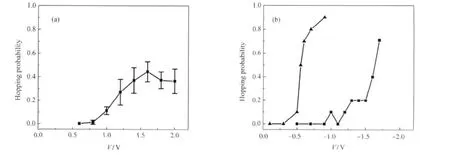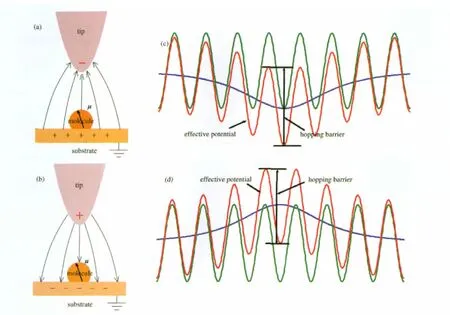隧道結電場輔助下叔丁胺分子在Cu(111)表面跳躍
許逾群 仉 君 袁秉凱 鄧 珂 楊 蓉 裘曉輝
(國家納米科學中心,北京 100190)
Understanding the elementary surface processes on single molecule level[1]is essential for rational catalyst design as well as for the development of molecular-based devices.In recent years, scanning tunneling microscope(STM)has been widely used in such studies and provided an insightful view on the adsorption of molecules on surfaces[2].High-resolution STM images allow the identification of the adsorption site of individual atoms and molecules[3].In addition,the interactions between adsorbates and substrates could be investigated by means of STM spectroscopy[4]and manipulation[5].For example,electron stimulated desorption has been reported for CO molecules on a Cu(111)substrate[6].The vertical transfer of molecule between tip and substrate is induced by the electronic excitation of CO via 2π*orbital.Lateral hopping of adsorbates on surface was also observed for various molecules.For CH3S on Cu(111)surface[7-8],the diffusion process is initiated by vibrational excitation.Meanwhile,the hopping direction of the molecule was determined by the coupling of molecular dipole with the electric field from the STM tip.
Here we investigated the hopping of tert-butylamine(t-BA) molecules(molecular formula(CH3)3CNH2)on Cu(111)surface using a ultrahigh vacuum low temperature STM.The hopping of t-BA molecules on surface was initiated by the tunneling electrons.However,the hopping behaviors of the molecules were distinct under the positive and negative bias voltages.The dipole moment of the t-BA molecule was taken into account for explaining the non-equivalent behaviors observed in the experi-ment.
1 Experimental
All STM experiments were performed in a STM(Omicron, Germany)with a base pressure below 1×10-8Pa.The Cu(111) surface(orientation accuracy<0.4°,MaTeck,Germany)was cleaned by several cycles of ion sputtering and annealing.Before the experiment,t-BA(99%,ACROS,USA)was purified by several freeze-pump-thaw cycles.The molecules were deposited through a variable leak valve on Cu(111)surface held at liquid N2temperature(78K).TheSTMimageswereobtainedattheconstant current mode at 78 K with electrochemically etched tungsten tips.
2 Results and discussion
Fig.1(a)presents a typical STM topography of isolated t-BA molecules on Cu(111)surface.In order to avoid unintentional displacement of the molecules during imaging,the sample bias voltage(VS)was set at 0.5 V with a tunneling current(IT)of 0.1 nA.Indi-vidual t-BA molecules on Cu(111)surface appear as round protrusions with an apparent height of 0.2 nm in the STM images,as shown in Fig.1(b).The random distribution of t-BA molecules on terraces and step edges indicates a strong moleculesubstrate interaction that inhibits the molecular diffusion on surface at such temperature.The geometric structure of an isolated t-BA molecule on the Cu(111)surface was calculated by the ab initio and density functional theory(DFT)methods,as shown in Fig.2(a).Fig.2(b)and Fig.2(c)show that the atop-site is found to be the most favorable adsorption site according to the simulation. The adsorption of t-BA molecules on Cu(111)surface is governed by the interac tion of the NH23s lone-pair electrons with Cu atoms,similar to the adsorption of NH3on Cu(111)surface[9]and pyrrolidineonCu(100)surface[10].
After the image was acquired,we placed the STM tip over the center of a target t-BA molecule and abruptly raised the bias voltage to a given value for a specific duration.STM feedback remained functional in the process to keep the tunneling current constant.As the pulse ended,the same area was imaged again to determine the adsorption site of the target molecule.Fig.3(a)and Fig.3(b)show that a t-BA molecule marked by a circle hops laterally due to the applied positive voltage pulses.The procedure is repeated on many t-BA molecules to make statistical analysis, and the hopping probability is the number of events that t-BA molecules change adsorption position on surface after each applied bias pulse.Lateral displacement of t-BA molecules was also observed under negative bias pulses,as shown in Fig.3(c)and Fig.3(d).

Fig.1 STM image(16 nm×16 nm)of t-BA molecules adsorbed on Cu(111)surface at 78 K(a)VS=0.5 V,IT=0.1 nA.Inset(b)is the line profile that shows the apparent height of t-BA molecule.The cross-section is taken along the solid line indicated in(a).
We measured the hopping probability of t-BA molecules as a function of the tunneling current at a given bias voltage.Fig.3(e) shows the data acquired at a positive bias pulse,VS=1.6 V,with varying tunneling current.The three lines of data in the plot were obtained with three tip conditions(Here,we intentionally modified the structure of tip apex by bringing the tip in contact with the Cu(111)surface.A trace was normally found on the substrate surface after the controlled collision.However,to avoid the accidental change in tip structure during each run of the measurement,the applied bias pulse is restricted to below 2 V). The different tips yielded consistent results,which all showed a linear dependence on the tunneling current.The observation suggests that the lateral hopping of t-BA molecule is a single electron event[6,11-12].

Fig.2 Chemical structure of t-BA molecule(a)and the optimized geometric structure of an isolated t-BA molecule on the Cu(111)surface by the ab initio and DFT calculation(b-c)

Fig.3 Topographic images of the hopping of a t-BA molecule on Cu(111)surface at 78 K(a-d)and hopping probability as a function of tunneling current(e-f)(a-b)under the positive bias pulse(4 nm×6 nm),(c-d)under the negative bias pulse(3.5 nm×8 nm);(e)at positive bias voltage of 1.6 V(duration(t)=1 s,each data point represents 50 trial events),(f)at negative bias voltage of-0.9 V(t=1 s,each data point represents 20 trial events).The STM feedback is kept on to maintain the tunneling current constant in the pulse duration.Different lines of data correspond to different tip conditions.
The hopping of t-BA molecule under negative bias pulse also shows a linear dependence.However,the hopping events seem to be highly sensitive to the tip conditions.The two lines of data shown in Fig.3(f)were acquired at the same tunneling conditions with two different tips.It is noticed that the hopping probability of the molecule is tip-dependent.This tip effect was not observed in the case when positive sample bias pulse was applied.
We further investigated the hopping probability of t-BA molecule as a function of bias voltage.The results were plotted in Fig.4.The STM feedback was kept on to maintain the tunneling current constant in the pulse duration.For positive voltage, the hopping probability was observed when bias voltage was above 0.75 V,as shown in Fig.4(a).This threshold was repeated for different tips and exhibited a downshift trend with the increase of tunneling current.In contrast,the statistics of negative voltage pulse did not yield a consistent threshold for different tip conditions,as shown in Fig.4(b).Additionally,the hopping probability of t-BA molecules under the negative voltage seems to be higher than that at the corresponding positive bias voltage.

Fig.4 Hopping probability of t-BA molecule as a function of the bias voltage with different tunneling currents(a)IT=2.0 nA,t=1 s,each data point represents 30 trial events;(b)IT=0.4 nA,t=1 s,each data point represents 10 trial events. Different sets of data correspond to different tip conditions.

Fig.5 Polar t-BA molecule subjected to a non-uniform electric field applied between the tip and the substrate under positive (a)and negative(b)bias voltage and the surface potential(the green line)of a t-BA molecule adsorbed on surface and the variation of the hopping barrier(the red line)of the molecule under opposite electric fields(c-d)The blue curves indicate the electric dipole potential of the molecule varying with external electric fields of different polarities.
The threshold voltage for activating t-BA molecules is beyond the energy range of molecular vibration,which is typically<400 mV[13].We thus suggested that the hopping process of t-BA molecules is induced via electronic excitation[6]rather than vibrational excitation[11,14-15]of the molecule.Calculations for NH3chemisorbed on Cu clusters showed that the lone pair orbital of NH3interacted with the free-electron type Cu(4s)and Cu(4p)orbitals, resulting in local density of state located a few eV below the Fermi level[16].Nevertheless,this molecular resonance was not identi fied in the tunneling spectroscopy performed on t-BA molecules because of the hopping of molecule at elevated bias voltages.
The t-BA molecule has a dipole moment of 4.14×10-30C·m (1.24 D[17-18]).Upon adsorption on Cu(111)surface,our ab initio calculation revealed that 0.32 electrons were further transferred from the t-BA molecules to the substrate.This electronic rearrangement tends to further increase the dipole moment of the molecular adsorbate on the substrate.The energy diagrams of a dipole moment subjected to external electric field of opposite polarity is illustrated in Fig.5.In approximation,the effective potential is Veff(Z,x)=V(Z,x)-μz·F=V(Z,x)+μz|F|[19-20].Here,μzis the dipole moment of t-BA molecules,F is the electric field applied between tip and substrate surface.The electric field is nonuniform,and it spatially varies surrounding the tip.Under the positive bias,the electric field points toward the STM tip,as shown in Fig.5(a).The coupling between the dipole of t-BA molecule and the applied electric field will increase the effective potential,as shown in Fig.5(b),leading to an increase of the hopping barrier of t-BA molecules.As a consequence,there is less chance for t-BA molecules to hop around on Cu(111)surface. In comparison,the electric field pointing toward the sample surface under the negative bias,as shown in Fig.5(c),induces an unfavorable coupling between the molecular dipole and the electric field.The decrease of the diffusion barrier leads to a higher hopping probability,as shown in Fig.5(d).In addition to this electric field effect,the diffusion of t-BA at negative bias could also be mediated by the electronic excitation via the unoccupied molecular orbitals[20],yielding non-equivalent behaviors under the positive and negative pulses.
3 Conclusions
In summary,we have investigated the hopping of t-BA molecules on Cu(111)surface induced by tunneling electrons. The linear dependence of hopping probability on tunneling current suggests a single-electron excitation process.The voltagepolarity dependent hopping behaviors of the molecules are explained by the variation of the potential energy of polar molecules under external electric field.
1 Ho,W.J.Chem.Phys.,2002,117:11033
2 Komeda,T.Prog.Surf.Sci.,2005,78:41
3 Lagoute,J.;Kanisawa,K.;F?lsch,S.Phys.Rev.B,2004,70: 245415
4 Bartels,L.;Meyer,G.;Rieder,K.H.Chem Phys.Lett.,1998,297: 287
5 Bartels,L.;Meyer,G.;Rieder,K.H.Appl.Phys.Lett.,1997,71: 213
6 Bartels,L.;Meyer,G.;Rieder,K.H.;Velic,D.;Knoesel,E.; Hotzel,A.;Wolf,M.;Ertl,G.Phys.Rev.Lett.,1998,80:2004
7 Ohara,M.;Kim,Y.;Kawai,M.Phys.Rev.B,2008,78:201405
8 Ohara,M.;Kim,Y.;Kawai,M.Jpn.J.Appl.Phys.,2006,45:2022
9 Biemolt,W.;van de Kerkhof,G.J.C.S.;Davies,P.R.;Jansen,A. P.J.;van Santen,R.A.Chem.Phys.Lett.,1992,188:477
10 Gaudioso,J.;Lauhon,L.J.;Ho,W.Phys.Rev.Lett.,2000,85: 1918
11 Komeda,T.;Kim,Y.;Kawai,M.;Persson,B.N.J.;Ueba,H. Science,2002,295:2055
12 Hla,S.W.J.Vac.Sci.Technol.B,2005,23:1351
13 Maksymovych,P.;Sorescu,D.C.;Yates,J.T.J.Phys.Chem.B, 2006,110:21161
14 Pascual,J.I.;Lorente,N.;Song,Z.;Conrad,H.;Rust,H.P.Nature, 2003,423:525
15 Bartels,L.;Wolf,M.;Klamroth,T.;Saalfrank,P.;Kühnle,A.; Meyer,G.;Rieder,K.H.Chem.Phys.Lett.,1999,313:544
16 van Santen,R.A.;Neurock,M.Molecular heterogeneous catalysis: a conceptual and computational approach.Weinheim:Wiley-VCH, 2006:92-93
17 Lide,D.R.Handbook of chemistry and physics.87th ed. Maryland:CRC Press,2006:9-51
18 Burgess,A.W.;Shipman,L.L.;Scheraga,H.A.Proc.Natl.Acad. Sci.U.S.A.,1975,72:854
19 Mo,Y.W.Science,1993,261:886
20 Saalfrank,P.J.Chem.Phys.,2000,113:3780

